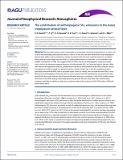| dc.contributor.author | Neely, R. R. | |
| dc.contributor.author | Yu, P. | |
| dc.contributor.author | Rosenlof, K. H. | |
| dc.contributor.author | Toon, O. B. | |
| dc.contributor.author | Daniel, J. S. | |
| dc.contributor.author | Miller, H. L. | |
| dc.contributor.author | Solomon, Susan | |
| dc.date.accessioned | 2015-10-06T17:41:21Z | |
| dc.date.available | 2015-10-06T17:41:21Z | |
| dc.date.issued | 2014-02 | |
| dc.date.submitted | 2013-07 | |
| dc.identifier.issn | 2169897X | |
| dc.identifier.uri | http://hdl.handle.net/1721.1/99160 | |
| dc.description.abstract | Recent observations reveal a seasonally occurring layer of aerosol located from 0° to 100°E, 20° to 45°N and extending vertically from about 13 km to 18 km; this has been termed the Asian tropopause aerosol layer (ATAL), and its existence is closely associated with the Asian summer monsoon circulation. Observational studies argue that the ATAL is a recent phenomenon, as the layer is not observed in the satellite record prior to 1998. This suggests that the ATAL may be of anthropogenic origin associated with a shift in the dominant regional emission of sulfur dioxide (SO[subscript 2]) to China and India in the late 1990s. Here we test the hypothesis that SO[subscript 2] emitted from Asia led to the formation of the ATAL using an aerosol microphysical model coupled to a global chemistry climate model. This is the first modeling study to specifically examine the ATAL and its possible origin. From our results, we conclude that the ATAL is most likely due to anthropogenic emissions, but its source cannot solely be attributed to emissions from Asia. Specifically, the results indicate that Chinese and Indian emissions contribute ~30% of the sulfate aerosol extinction in the ATAL during volcanically quiescent periods. We also show that even small volcanic eruptions preclude our ability to make any conclusions about the existence of the ATAL before 1998 with observations alone. | en_US |
| dc.description.sponsorship | National Science Foundation (U.S.) (ATM-0856007) | en_US |
| dc.description.sponsorship | United States. National Aeronautics and Space Administration (Grant NNX09AK71G) | en_US |
| dc.language.iso | en_US | |
| dc.publisher | Wiley Blackwell | en_US |
| dc.relation.isversionof | http://dx.doi.org/10.1002/2013jd020578 | en_US |
| dc.rights | Article is made available in accordance with the publisher's policy and may be subject to US copyright law. Please refer to the publisher's site for terms of use. | en_US |
| dc.source | Prof. Solomon via Chris Sherratt | en_US |
| dc.title | The contribution of anthropogenic SO[subscript 2] emissions to the Asian tropopause aerosol layer | en_US |
| dc.type | Article | en_US |
| dc.identifier.citation | Neely, R. R., P. Yu, K. H. Rosenlof, O. B. Toon, J. S. Daniel, S. Solomon, and H. L. Miller. “The Contribution of Anthropogenic SO[subscript 2] Emissions to the Asian Tropopause Aerosol Layer.” J. Geophys. Res. Atmos. 119, no. 3 (February 15, 2014): 1571–1579. © 2014 American Geophysical Union | en_US |
| dc.contributor.department | Massachusetts Institute of Technology. Department of Earth, Atmospheric, and Planetary Sciences | en_US |
| dc.contributor.approver | Solomon, Susan | en_US |
| dc.contributor.mitauthor | Solomon, Susan | en_US |
| dc.relation.journal | Journal of Geophysical Research: Atmospheres | en_US |
| dc.eprint.version | Final published version | en_US |
| dc.type.uri | http://purl.org/eprint/type/JournalArticle | en_US |
| eprint.status | http://purl.org/eprint/status/PeerReviewed | en_US |
| dspace.orderedauthors | Neely, R. R.; Yu, P.; Rosenlof, K. H.; Toon, O. B.; Daniel, J. S.; Solomon, S.; Miller, H. L. | en_US |
| dc.identifier.orcid | https://orcid.org/0000-0002-2020-7581 | |
| mit.license | PUBLISHER_POLICY | en_US |
| mit.metadata.status | Complete | |
